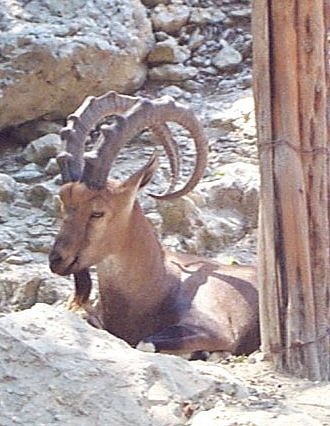ZooPax
The Horn Section
You are probably familiar with musical
instruments called "horns." In a band or orchestra, the horns are made out of
brass, have a small hole at one end that you blow into, and a large flared bell
at the other end. In between is a long tube. Modern orchestral horns are the
descendants of earlier instruments made from real animal horns. The shofar,
usually made from a ram's horn, is still used today in Jewish religious
ceremonies. What are horns and how are they different from other structures
that grow out of animals' heads, for example antlers?
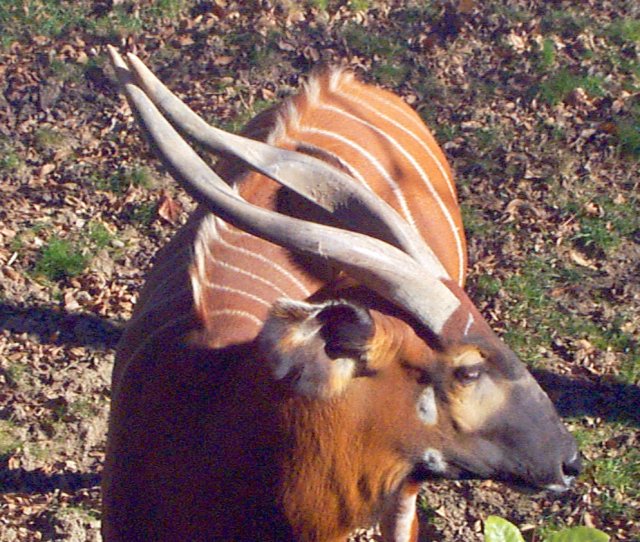 Check out the gracefully curved
horns on this female bongo antelope. Click on the picture to enlarge it and
notice how smoothly it seems to grow out of the animal's head. In living
species, true horns are found only in animals that have split hooves -- the
Artiodactyla. These hooved animals keep their weight on the two middle toes --
corresponding to your middle and ring fingers. Actually most of what is on the
ground is the hoof, which is like your fingernails, only much thicker. Your
fingernails are made out of a strong fibrous protein called keratin. The
covering of horns is made from the same material.
Check out the gracefully curved
horns on this female bongo antelope. Click on the picture to enlarge it and
notice how smoothly it seems to grow out of the animal's head. In living
species, true horns are found only in animals that have split hooves -- the
Artiodactyla. These hooved animals keep their weight on the two middle toes --
corresponding to your middle and ring fingers. Actually most of what is on the
ground is the hoof, which is like your fingernails, only much thicker. Your
fingernails are made out of a strong fibrous protein called keratin. The
covering of horns is made from the same material.
Do horns grow out just the way that fingernails
do? Almost. Imagine that instead of your fingernail only covering the top of
your finger, it grew out all away around the tip! Horns are hollow, but at the
base, the keratin covers a core made out of bone. This bony core initially develops
within the skin, but then becomes fused to the skull. Horns grow continuously
throughout the animal's life. The growth rate is not even. Horn growth is affected
by hormones, so the thickness of the keratin covering varies during the year,
and in some species can form visible rings. Check out the growth pattern on
the Nubian ibex below. These pictures were taking of the same animal in three
different years: 1999, 2000, and 2003. What difference do you see between the
horns of this animal? How could different growth rates produce curved horns?
Research Project: Do your fingernails grow
at the same rate all year long? How could you find out?
In addition to being members of the
mammalian Order Artiodactyla, nearly all horned animals are Bovids (Family
Bovidae). Bovids include cattle, antelopes, sheep and goats. In some species,
both males and females may have horns, while in others horns are found only in
males. Compare the pair of anoas (a small species of buffalo) on the left with
the lesser kudus on the right. How is the female different from the male in
these two pairs? The kudus are classified in the same genus (Tragelaphus, which
means "goat-deer") as the bongo at the top of the page. How would you expect
the horns of the bongo male to be different from those of the female? Test your
hypothesis by going to the zoo and finding the bongo male, or by looking for a
picture of a bongo male on the Internet. When you visit the zoo, make a list of
which bovid females (cattle, antelope, sheep goats) have horns and which ones
don't. Are there any species in which the males don't have horns?
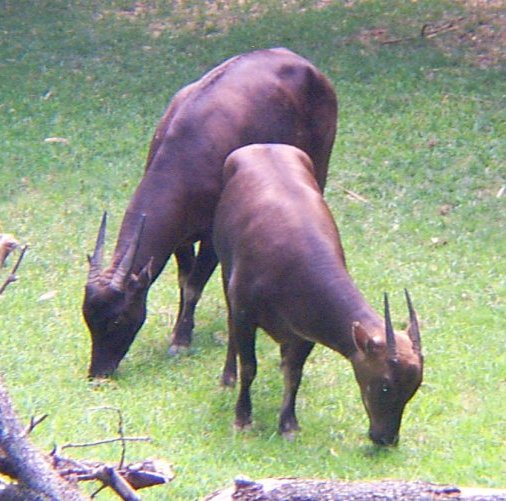
Anoas |
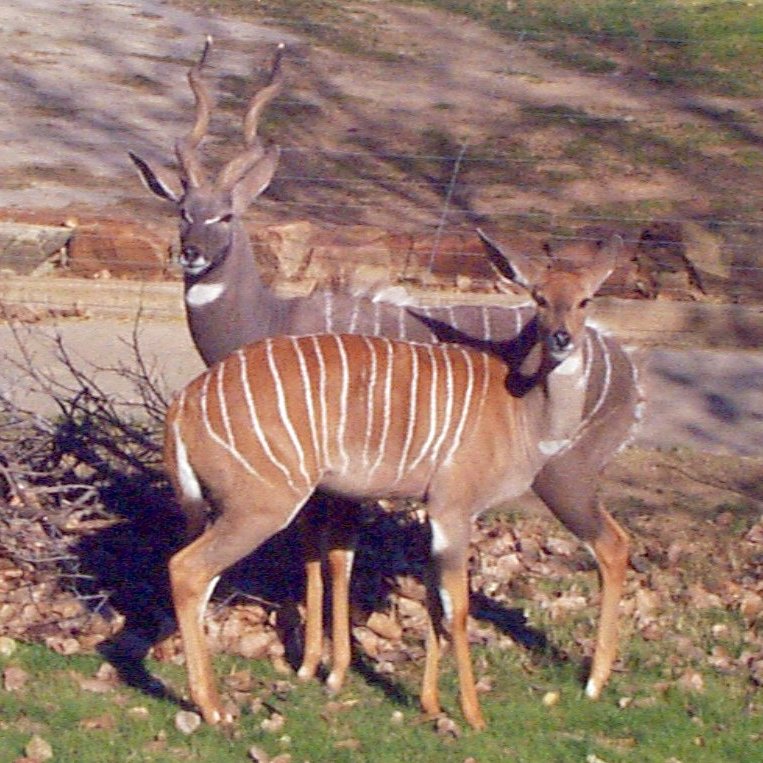
Lesser Kudu |
 What are
horns for? That is, what function do they serve for the animal? Look at the two
Nubian ibex at the left. What are they doing with their horns? Could their
horns also help them ward off predators?
What are
horns for? That is, what function do they serve for the animal? Look at the two
Nubian ibex at the left. What are they doing with their horns? Could their
horns also help them ward off predators?
Remember that in some species of bovids,
females do not have horns. Find some species in which both sexes have horns.
Are they the same size in both sexes?
Based on what you discover, what do you
think the major function of horns is: to establish male social dominance or to
defend against predators?
Another group of hooved animals has
a different kind of growth on the head: antlers. Antlers are found in the deer
family (Cervidae). Compare the antlers of the white-tailed deer below with the
horns of the gerenuk, another Bovid. How are they similar? How are they
different? Apart from the physical differences you can observe below, antlers
also grow differently from horns. Notice that the antlers of the deer look
fuzzy. Antlers are formed of bone, but are covered by fuzzy skin (velvet) when
they first grow out. The bone under the velvet is also somewhat "soft," as the
growing antler is composed of cartilage that is gradually replaced by bone.
The picture below was taken in July. By
late August or early September, the bony core will be hardened, and the skin
cover will lose its blood supply and dry out. The male will rub the drying skin
off to expose the bony antlers underneath. After the end of the mating season,
this male will lose his antlers. The minerals in the bone at the base of the
antlers are absorbed into the bloodstream and the antler becomes weak at this
point and breaks off . However there is a small group of living cells that will
make the new pair of antlers in the next breeding season. Considering the
information above, which grows faster, horns or antlers?
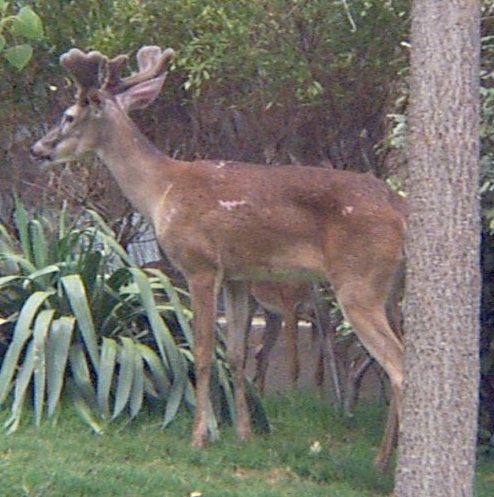
White-tailed Deer (Male)
(Above: male
in July)
Male in September-Note increased
growth
Male in October--Antlers
emerged |
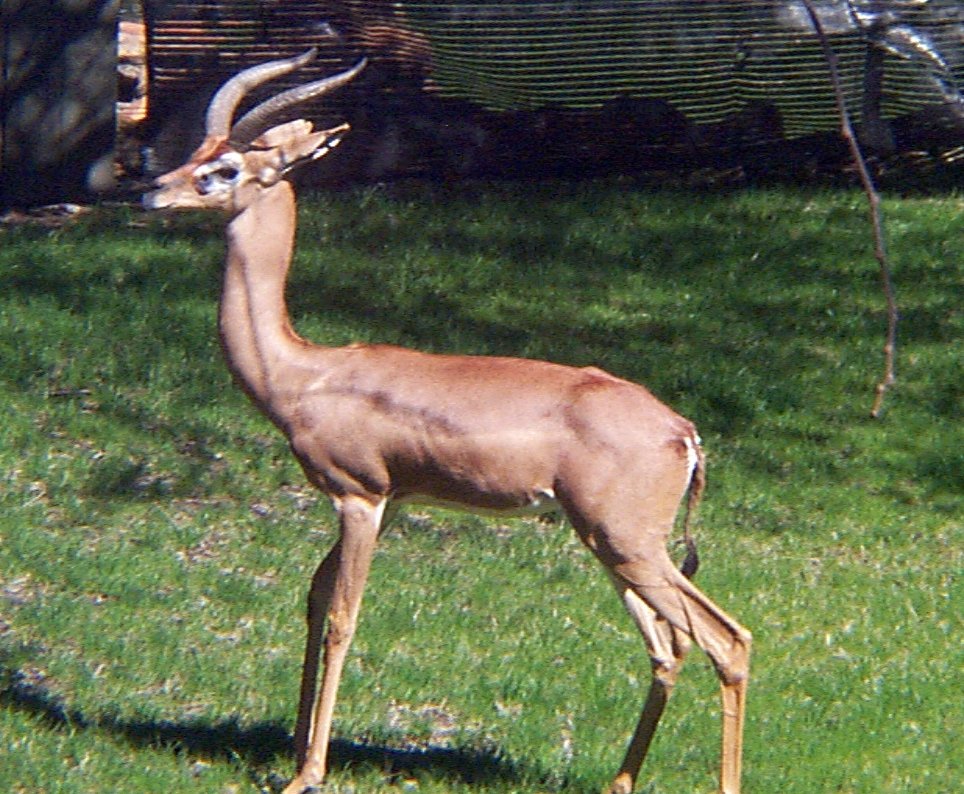
Gerenuk (Male)
(This photo was taken in June)
|
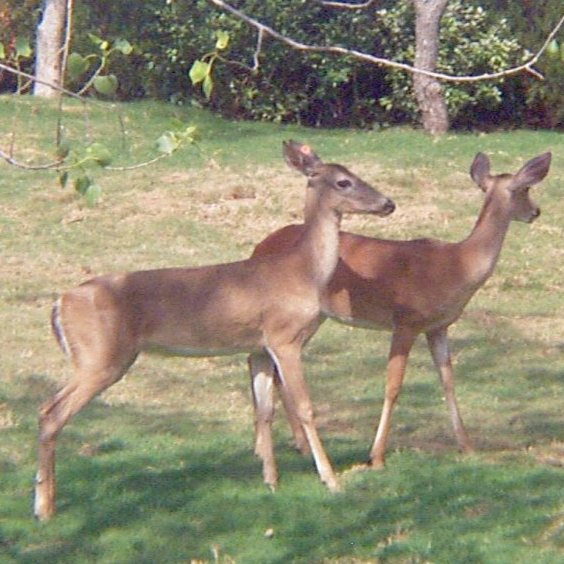
White-tailed deer (Female) |
The animals to the left
are white-tail females. With one exception, female deer do not grow antlers.
The exception is reindeer or caribou. Like other deer, the males lose their
antlers at the end of the breeding season, around the first of December.
Females have small antlers that are not lost at the end of the breeding season.
Trivia Question:
Christmas comes near the end of December. Since in all the pictures of Santa's
reindeer, the 8 adults all have their antlers, what sex must they be?
|
|
In the tufted deer, the tiny antlers
are barely visible in the brush of long stiff hairs on top of its head. Only
males have these antlers. However in this and some other small deer, the males
can back up their antlers with long upper canines. In the animal to the right,
both antlers and teeth are just visible. |
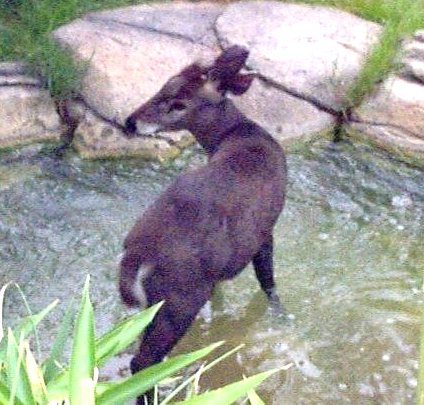 |
Below are three more animals with horns.
These are also hooved animals, but in a different group than the Bovids and
Cervids, who are both Artiodactyla. Rhinos (and horses and tapirs) are members
of the Perissodactyla, a group of hooved animals whose legs are centered over
the middle toe. Their horns are on their noses. They are like bovid horns in
two ways: they are made of keratin and they grow continuously. But unlike
antelope horns, they are solid keratin fibers all the way through. Look at the
differences in the shape and numbers of the horns in the three animals below:
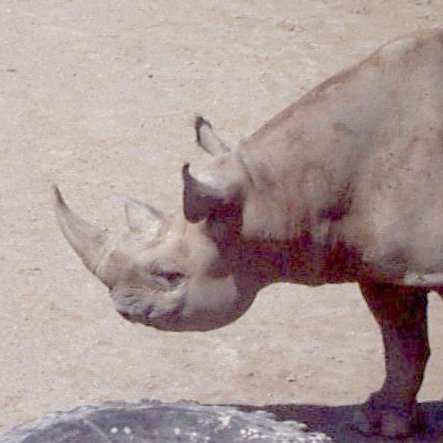
Black Rhino |

White Rhino |
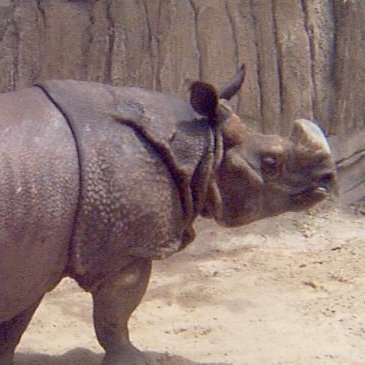
Greater One-Horned Asian
Rhino |
At the Fort Worth Zoo, there are males and
females of all three rhino species. Do both sexes have horns? Are the horns
similar in the two sexes? You can shape your fingernails by filing them. How
might a rhino shape its horn? Since rhino horns are made only of keratin, would
you expect rhino skulls to have the horn? After you have made your prediction,
click here.
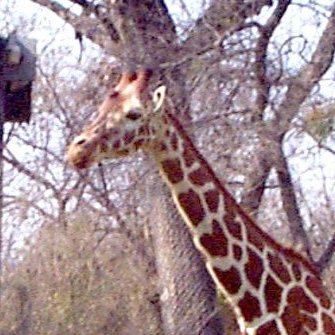 What about these horns? This is
also in a hooved animal that belongs to the Artiodactyla. However giraffes are
not bovids. The horns of giraffes are made of bony outgrowths directly from the
skull. Instead of a keratin covering, they are covered with skin and hair. The
hair at the tips of the horns is longer and dark. Males tend to wear this dark
tuft of hair off when they spar with other males. Do you think the giraffe in
the picture is male or female? Look at the bump in the middle of this animals
forehead. Some giraffes have more than two horns. When you go to visit the
giraffes, look for animals with more than two horns. During your visit, look at
the baby giraffes in the group. Do baby giraffes have horns?
What about these horns? This is
also in a hooved animal that belongs to the Artiodactyla. However giraffes are
not bovids. The horns of giraffes are made of bony outgrowths directly from the
skull. Instead of a keratin covering, they are covered with skin and hair. The
hair at the tips of the horns is longer and dark. Males tend to wear this dark
tuft of hair off when they spar with other males. Do you think the giraffe in
the picture is male or female? Look at the bump in the middle of this animals
forehead. Some giraffes have more than two horns. When you go to visit the
giraffes, look for animals with more than two horns. During your visit, look at
the baby giraffes in the group. Do baby giraffes have horns?
Make a list of the differences
between the horns and antlers you have seen today. What kinds of combinations
have not been discussed? Do you think animals might exist that have those
combinations? Do you think that some extinct hooved animals might have had
horns different from those seen in living animals? Here are some references to
help you answer these questions:
|
The Ultimate Ungulate:
http://www.ultimateungulate.com/
Two references on the
Perissodactyla:
Two references on the
Artiodactyla:
Are there other examples of horns
that you think should be added to this ZooPax? E-mail
zoopax@whozoo.org. If your suggestion
is used, we will give you and your school a credit and identify your
contribution. |
 Check out the gracefully curved
horns on this female bongo antelope. Click on the picture to enlarge it and
notice how smoothly it seems to grow out of the animal's head. In living
species, true horns are found only in animals that have split hooves -- the
Artiodactyla. These hooved animals keep their weight on the two middle toes --
corresponding to your middle and ring fingers. Actually most of what is on the
ground is the hoof, which is like your fingernails, only much thicker. Your
fingernails are made out of a strong fibrous protein called keratin. The
covering of horns is made from the same material.
Check out the gracefully curved
horns on this female bongo antelope. Click on the picture to enlarge it and
notice how smoothly it seems to grow out of the animal's head. In living
species, true horns are found only in animals that have split hooves -- the
Artiodactyla. These hooved animals keep their weight on the two middle toes --
corresponding to your middle and ring fingers. Actually most of what is on the
ground is the hoof, which is like your fingernails, only much thicker. Your
fingernails are made out of a strong fibrous protein called keratin. The
covering of horns is made from the same material. 